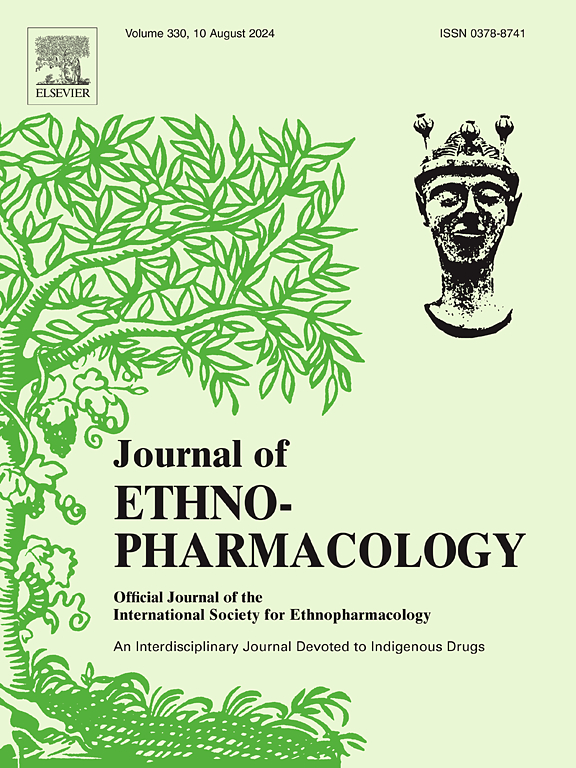Hua Zheng San Ji Fang promotes ferroptosis through Keap1/Nrf2 pathway in hepatocellular carcinoma cells
IF 5.4
2区 医学
Q1 CHEMISTRY, MEDICINAL
引用次数: 0
Abstract
Ethnopharmacological relevance
Hua Zheng San Ji Fang (HZSJF) is a traditional Chinese medicinal formula comprising 11 authenticated herbs that have historically been used to treat liver ailments. Its multi-component and multi-targeted nature makes it a promising therapeutic agent for hepatocellular carcinoma (HCC), particularly via the modulation of ferroptosis, a regulated form of cell death.
Aim of the study
This study aimed to investigate the anticancer effects of HZSJF on hepatocellular carcinoma (HCC) cells and elucidate the underlying mechanisms, with a particular focus on ferroptosis and the Keap1/Nrf2 oxidative stress pathway.
Materials and methods
HZSJF was extracted through a dual aqueous decoction and concentrated to 741 g/L. The effects of the extract were assessed on SK-HEP-1 and HepG2 cells using viability, proliferation, migration, and invasion assays. Ferroptosis biomarkers and signaling components were evaluated using biochemical assays, qRT-PCR, immunofluorescence, and western blotting. A subcutaneous xenograft model was used for in vivo validation.
Results
HZSJF significantly inhibited the proliferation, migration, and invasiveness of HCC cells. It induced ferroptosis by elevating lipid peroxidation and intracellular Fe2+, reducing GSH and SOD levels, and downregulating GPX4, FTH-1, and SLC7A11. Mechanistically, HZSJF upregulated Keap1 and suppressed Nrf2/HO-1 signaling, thereby enhancing oxidative stress. These effects were reversed by ferroptosis inhibitors and modulated by Keap1 overexpression. In vivo, HZSJF inhibited tumor growth and induced the molecular effects observed in vitro.
Conclusions
HZSJF promotes ferroptosis and suppresses HCC progression by targeting the Keap1/Nrf2 axis. These findings support its potential as a natural multitarget therapeutic agent for liver cancer management.

花正散除方通过Keap1/Nrf2通路促进肝癌细胞铁凋亡。
民族药理学相关性:花正散积方(HZSJF)是一种传统的中药配方,由11种经过认证的草药组成,历史上被用来治疗肝脏疾病。其多组分和多靶点特性使其成为治疗肝细胞癌(HCC)的有希望的药物,特别是通过调节铁下垂(一种受调节的细胞死亡形式)。研究目的:本研究旨在探讨HZSJF对肝细胞癌(HCC)细胞的抗癌作用,并阐明其潜在机制,重点关注铁凋亡和Keap1/Nrf2氧化应激途径。材料与方法:采用双水煎法提取HZSJF,浓缩至741 g/L。通过活力、增殖、迁移和侵袭试验评估提取物对SK-HEP-1和HepG2细胞的影响。使用生化分析、qRT-PCR、免疫荧光和western blotting评估铁下垂生物标志物和信号成分。皮下异种移植物模型用于体内验证。结果:HZSJF能明显抑制肝癌细胞的增殖、迁移和侵袭。它通过提高脂质过氧化和细胞内Fe2+,降低GSH和SOD水平,下调GPX4、FTH-1和SLC7A11来诱导铁下垂。机制上,HZSJF上调Keap1,抑制Nrf2/HO-1信号,从而增强氧化应激。这些作用被铁下垂抑制剂逆转,并被Keap1过表达调节。在体内,HZSJF抑制肿瘤生长,诱导体外分子效应。结论:HZSJF通过靶向Keap1/Nrf2轴促进铁下垂并抑制HCC进展。这些发现支持其作为肝癌治疗的天然多靶点治疗剂的潜力。
本文章由计算机程序翻译,如有差异,请以英文原文为准。
求助全文
约1分钟内获得全文
求助全文
来源期刊

Journal of ethnopharmacology
医学-全科医学与补充医学
CiteScore
10.30
自引率
5.60%
发文量
967
审稿时长
77 days
期刊介绍:
The Journal of Ethnopharmacology is dedicated to the exchange of information and understandings about people''s use of plants, fungi, animals, microorganisms and minerals and their biological and pharmacological effects based on the principles established through international conventions. Early people confronted with illness and disease, discovered a wealth of useful therapeutic agents in the plant and animal kingdoms. The empirical knowledge of these medicinal substances and their toxic potential was passed on by oral tradition and sometimes recorded in herbals and other texts on materia medica. Many valuable drugs of today (e.g., atropine, ephedrine, tubocurarine, digoxin, reserpine) came into use through the study of indigenous remedies. Chemists continue to use plant-derived drugs (e.g., morphine, taxol, physostigmine, quinidine, emetine) as prototypes in their attempts to develop more effective and less toxic medicinals.
 求助内容:
求助内容: 应助结果提醒方式:
应助结果提醒方式:


